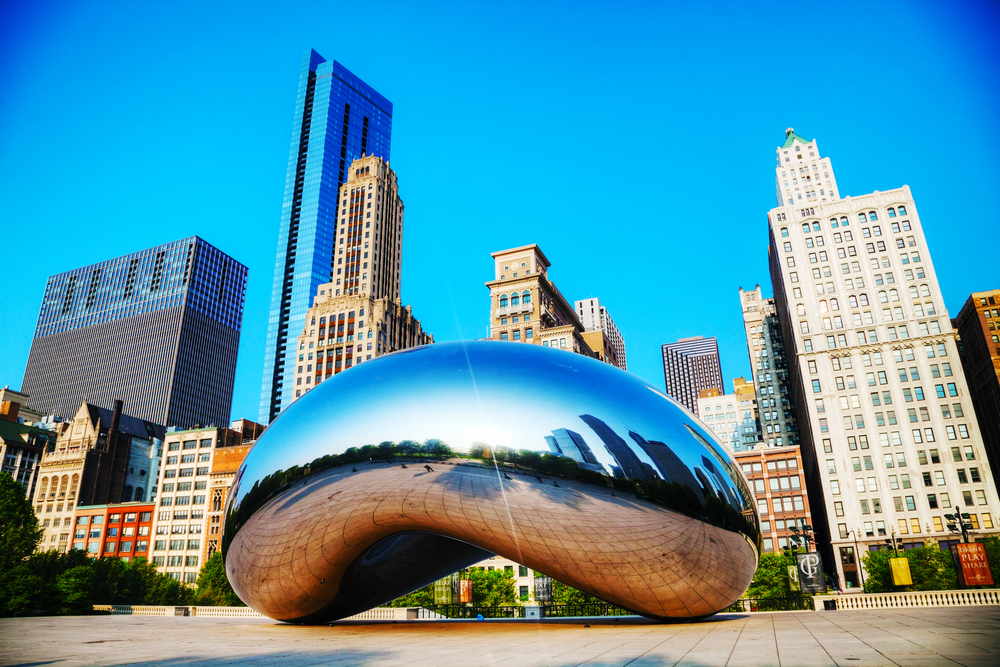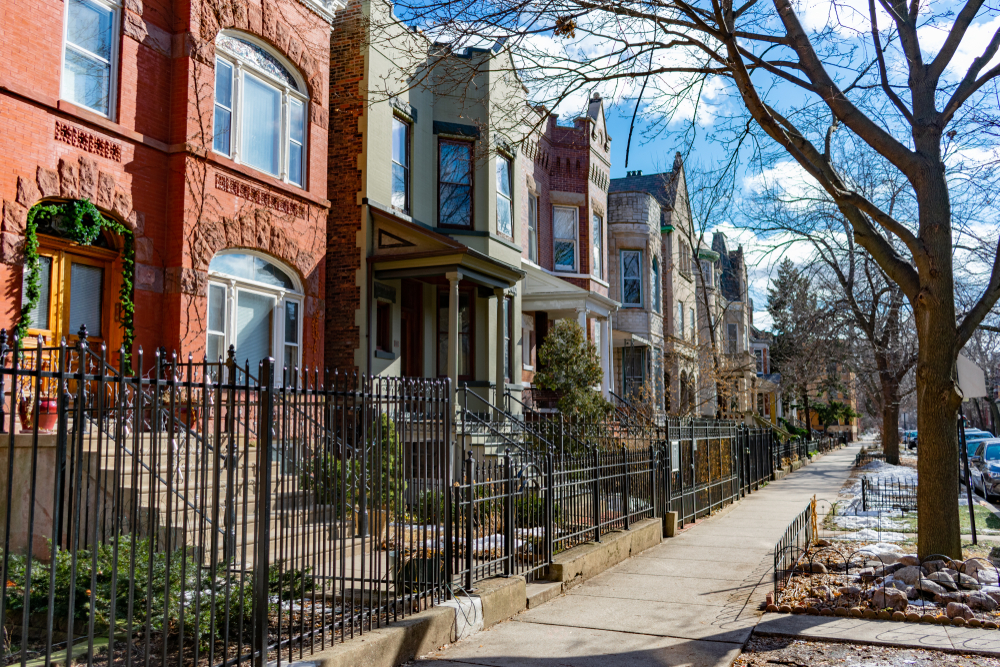In This Moving Guide:
- Chicago at-a-glance
- What it’s like to live in Chicago
- Economy and job outlook in Chicago
- Real estate, cost of living in Chicago
- The top neighborhoods in Chicago
- How to get around in Chicago
- School and education snapshot
- Weather and climate in Chicago
- 10 can’t miss things to do in Chicago
Chicago At-A-Glance
Found along the shores of Lake Michigan, Chicago is the third-largest city in the U.S. and is the most populous city in the Midwest. It is also the birthplace of the skyscraper which has had such a major influence on architecture at a global scale. Its current slogan, “Chicago Not in Chicago,” is all about recognizing the spaces of other metropolitans that were designed or influenced by Chicagoans.
As a center of international trade and commerce, and a home to people from around the world, it is considered a diverse global city with thriving industries, great higher education options, and urban beaches that—for those moving to Chicago from the east or west coasts—won’t have you feeling too homesick for the ocean.
Full of professionals, families, and more, Chicago is just one of those cities that has something of interest for everyone.
Chicago is a Cultural Melting Pot
In 2022, Condé Nast Traveler readers voted Chicago the best city in the U.S., and not for the first time—Chicago has received the honor for six years in a row. With its historic, beautiful architecture, world-class museums, great dining options and breweries, Chicago has a lot to offer.
No, really, it has a lot to offer.
Chicago is the definition of “melting pot,” with seven professional sports teams; 36 annual parades; 40 annual film festivals; plenty of street festivals and art fairs, over 200 theaters, and more. It is considered one of the best places in the world to see sketch or improv comedy, with more serious productions, like Broadway in Chicago, found in the Loop.

Living in Chicago also means fine dining from world-renowned chefs. The city has 7,300 restaurants, seven of which are AAA Diamond-rated and 26 that are Michelin-starred. With its diverse residents, you can expect to find delicious global cuisine, such as Hispanic-inspired dishes in Pilsen or Little Village, Asian delicacies in Chinatown, Indian and Pakistani favorites in West Ridge, as well as Greek, Italian, and more throughout the city.
Job Growth Opportunities in Manufacturing, Finance, and More
Throughout 2022, Chicago has seen significant job growth, with a 4.4% increase over the same time last year, a higher jump than was seen nationally. This brought Chicago to number three on the list of 12 largest metropolitan areas in the U.S. for over-year employment rates.
One of Chicago’s top industries is manufacturing, but other industries, such as printing and publishing, finance, insurance, and food processing, play a major economic role. Some of the top employers in Chicago include JPMorgan Chase, Deloitte, Allstate, Boeing, Ford Motor Company, and more.Since September 2021, the unemployment rate has decreased and as of September 2022 was at 4.4%.
World-Class City at a High(ish) Cost of Living
Although in 2021 the median household income was $65,781, slightly below the national average, the cost of living in Chicago is 22% higher than the U.S. average. That said, Chicago doesn’t even make the top-25 lists of most expensive cities, so moving to Chicago could mean big city advantages with a lower price point than, say, New York or Seattle.
The difference between cost of living and median income could be why more than half of Chicagoans rent their homes. Although compared to the same time last year rents have increased, Apartment List’s December 2022 rent report showed the growth slowing down with median rent prices having decreased month-over-month. As of that report, the median price of a one-bedroom apartment was reported as $1,292, with a two-bedroom median price at $1,402.
For those looking to buy, the median sales price of homes in November 2022 was $348,584, up 1.3% from the same time last year. Those numbers came with good news, though: RocketHomes projects that Chicago is moving from a seller’s market into a buyer’s market, with the number of available homes going up 4.4% since October 2022 and staying on the market longer. This means prices may start to come down.
Like any other major metro area, Chicago has its more affordable neighborhoods, too.
Chicago Offers a Mix of Communities and Neighborhoods
It’s good to understand that, officially, Chicago is divided into 77 community areas rather than neighborhoods. This is largely for urban planning and data purposes, so the locals’ idea of a neighborhood may not always align with the official definition. Regardless, for those living in Chicago, there are plenty of diverse spaces to call home.

Check out these highly recommended neighborhoods for those moving to Chicago:
LINCOLN PARK
One of the city’s most popular areas, Lincoln Park is considered a quaint, family friendly neighborhood with access to big city amenities. Because of that, residents are a mix of young professionals, families, and students.
LAKEVIEW
Just north of Lincoln Park, Lakeview is often broken down into smaller neighborhoods by locals. This community—home to Wrigley Field!—is ranked high for safety and boasts a laid back vibe with plenty of pubs, neighborhood hot spots, music festivals, and vintage shopping.
THE LOOP
Modern, high-rise living defines this bustling center in downtown Chicago. Named for the circle of cable cars that used to extend from this area, the Loop is still the center of transportation, giving residents easy access to the rest of the city.
WICKER PARK & BUCK TOWN
Forget about high rises and enjoy a small city/local vibe full of historic buildings and brownstones. This trendy area promises great shopping, plenty of art, live music, yummy restaurants, and some of the best coffee shops in Chicago.
SOUTH LOOP
Located just below the Loop, South Loop is home to professionals, couples, and young families. The nightlife isn’t as vibrant as some other neighborhoods, but with Museum Campus and plenty of other activities, this neighborhood offers the downtown feel in a more relaxed setting.
Other neighborhoods to include in your Chicago home search:
- Streeterville
- West Town
- River North
- West Loop
- Logan Square
The Second Largest Public Transportation System in the U.S.
Not only is Chicago growing in population, it’s also a transportation hub with plenty of trucks passing through. This may be why TomTom named the Windy City the sixth worst metro for traffic in 2022.What Chicago lacks in traffic, it more than makes up for with its public transit system. The Chicago Transit Authority (CTA) covers the city and 35 surrounding suburbs, making it the second largest public transportation system (and the sixth best according to AllTransit). Most folks riding the CTA take the bus, which offers 140 routes, some of which operate on a 24-hour service. The rail system, or “L,” has eight rapid transit routes, with two lines (Red and Blue) also operating 24 hours a day.
Plenty of Top-Ranking Higher Education Opportunities
For those with families, Chicago’s public school system has nearly 650 schools, and there are over 350 private schools to choose from as well. After K-12, Chicago has several top-ranking colleges and universities to choose from, including the University of Chicago, Northwestern University, University of Illinois, Illinois Institute of Technology, the Art Institute of Chicago, DePaul University, Loyola, and more.
Experience All Four Seasons—with Extra Chilly Winters
Some may be surprised to know that Chicago didn’t get its well-known nickname, “The Windy City,” because of its actual winds. Actually, the city is only slightly windier than the average U.S. cities and is not even in the top ten windiest cities in the country.

So, what is the climate in Chicago really like? Chicago is an all-season city, meaning residents experience cold winters with plenty of snow and walloping windchills, warm and humid summers, with gentler springs and falls in between.
Average temperatures vary from 22 to 83 degrees Fahrenheit, although they dip closer to freezing in Chicago’s harsh January weather and may creep up toward the 90s in muggy July or August.
10 Can’t-Miss Things to Do in Chicago
Full of world-class cultural institutions, hundreds of beautiful parks, and of course the Chicago Bears, this city has a lot going on all year long. Here’s a list of 10 must-dos in Chicago:
- Get a taste of Chicago’s sports culture and history at Wrigley Field, the second oldest Major League Baseball stadium in the U.S. and home to the Chicago Cubs.
- View masterpieces from every era at the Art Institute of Chicago, which has a permanent collection made up of more than 300,000 artworks, including Georges Seurat’s A Sunday on La Grande Jatte.
- Snap a selfie in front of Cloud Gate, Chicago’s famous reflective bean-shaped sculpture, found in Millennium Park.
- While you’re visiting Millennium Park, check out the Chicago Cultural Center, the country’s first free municipal cultural center, where you’ll experience plenty of beautiful architecture, art exhibitions, and programming.
- Explore eight indoor gardens full of tropical plants, ferns, and cacti in the Garfield Park Conservatory.
- Chicago-style or New York-style pizza? Grab a slice of Chicago’s deep dish for a little culinary research and weigh in on the debate.
- Listen to some jazz at The Green Mill Cocktail Lounge, once frequented by famous gangsters like Al Capone in the 1920s.
- Visit Lincoln Park to get your laugh on at the Second City, where big-name comedians like Tina Fey, Steve Carell, and Bill Murray once practiced their comedy.
- While you’re in the neighborhood, take a free stroll through the Lincoln Park Zoo, home to over 1,000 animals from around the world. (If you’re visiting during the holidays, you may just catch their iconic light show.)
- Get all your shopping done on the Magnificent Mile, a stretch of Michigan Avenue that boasts over 450 retailers, top-notch eateries, and luxury hotels.






